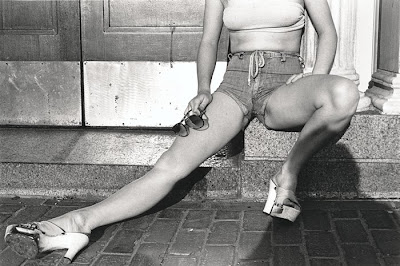To focus the research, photography of specifically of people on stairs was selected to locate relevant images for discussion. Initial investigation has identified a huge number of images on stairs - many posed and commercial shots, some snapshots and mostly images of people walking on stairs. General google image searches were conducted to locate images, and now more specific keyword searches on Flickr have begun.
 | |
| Google Image search results - people sitting on stairs. |
 | |
| Google Image search results - people sitting on stairs. |
The huge volume of random images, show that photography on stairs is a strong recurring theme. But how to make sense if so many varied images, take under such a variety of conditions? I feel that focusing (as much as possible) primarily on work by documentary photographers, street photographers, artists and dedicated projects will give a further targeted pool of images to examine. It is also emerging that images should be narrowed to doorways and doorsteps, rather than simply steps in general. This may include static portrait style shots or other activity, or movement through the threshold zone of a doorway or doorstep. This is more in keeping with the original research intention.
So far, a number of interesting photographers, artists, images, projects and exhibitions have been located which discuss the themes.
Interesting resources which have been identified so far. These form a snapshot of my thinking so far, and through investigation of these resources I hope to establish a more coherent proposal and direction for the essay.
Key Articles
Didier Aubert. “The doorstep portrait: intrusion and performance in mainstream American documentary photography.” Visual Studies. Apr2009, Vol. 24 Issue 1, p3-18.
Elizabeth Chapman. “A response to Didier Aubert” Visual Studies, Vol. 25, No. 2, September 2010
These article deal with doorstep photography as a sub-genre of documentary photography. As Chapman says, Aubert “shows the methodological and ethical concerns routinely encountered and resolved when the documentary photographer wants to display the private for public consumption. Doorstep photography is the conventional (inevitable?) ‘answer’ to the perennial problem of gaining access yet avoiding intrusion, unwanted exposure.”
Artists
Sam Kiang Li: At Our Doorsteps
Li has photographed residents in his apartment building in Singapore.
http://invisiblephotographer.asia/2012/05/10/photoessay-atourdoorsteps-samkangli/
Michael Wolf's project are of continued interest as a number of his projects talk about issues of privacy and voyeurism.
 |
| Michael Wolf - Bastard Chair #17 |
 | |
| Michael Wolf - Bastard Chair #20 |
Nigel Henderson (part of the Independent Group), and associated with the Smithsons. Some of his work focuses on the streetscape and interface between buildings and the street. In particular it documents children playing on the street.
 |
| Nigel Henderson Bethnal Green, 1949-52 |
 |
| Nigel Henderson Chisenhale Road, 1951 |
Exhibitions
 |
| John Goodman Tremont Street #3, Boston, 1978 from the exhibition Exposed: Exposed: Voyeurism, Surveillance and the Camera |
Exposed: Voyeurism, Surveillance and the Camera
This exhibition focuses on the idea of the unseen photographer. This is of interest as this idea implies that the subject doesn't know they are being photographed, or exactly when and what image(s) are captured. It also implies a potential invasion of privacy.
http://www.tate.org.uk/whats-on/tate-modern/exhibition/exposed
The Skinned City
From the exhibition description-
"In an attempt to observe and grasp our surroundings, all works exhibited are focusing on margins rather than actual buildings, on the liminal spaces and ambiguous boundaries marking out the city and the different places within it. Accordingly, the show promotes some rather idiosyncratic takes on the world around us: often on the edges of the visible, the works unpeel the city space and its various layers – not to arrive at a ‘deeper truth’, but to undo the many planes of a cityscape."
http://www.guestprojects.com/past/skinned-city/
I like the premise of this exhibition, and think there is potential in discussing imagery of doorsteps and thresholds along these lines. However, there is limited imagery of the exhibition itself, and none of the images seems to capture the concern with the public and private I see.
Additional Texts
Whalan, M. 2011, The Majesty of the Moment Sociality and Privacy in the Street Photography of Paul Strand, American Art, 2, p. 34,
Nour Dados. Liminal transformations: folding the surface of the photograph. Conserveries
mémorielles#7 | 2010: Seuils, Thresholds, Soglitudes
Further Research threads
Liminal space - Susan Sontag, Walter Benjamin...
No comments:
Post a Comment